The document discusses quicksort analysis and ways to improve its performance. It shows that quicksort has a best case running time of O(n log n) when keys are randomly distributed, but a worst case of O(n^2) if the array is already sorted. To avoid the worst case, the document suggests improving pivot selection by choosing the median of three randomly selected elements rather than just the first element. It also recommends using brute force for small subarrays of size 3 or less.

![Recursion: Quicksort Sub-
arrays
7 20 10 30 40 50 60 80 100
[0] [1] [2] [3] [4] [5] [6] [7] [8]
<= data[pivot] > data[pivot]](https://image.slidesharecdn.com/quicksort-150701093646-lva1-app6891/75/Quick-sort-2-2048.jpg)
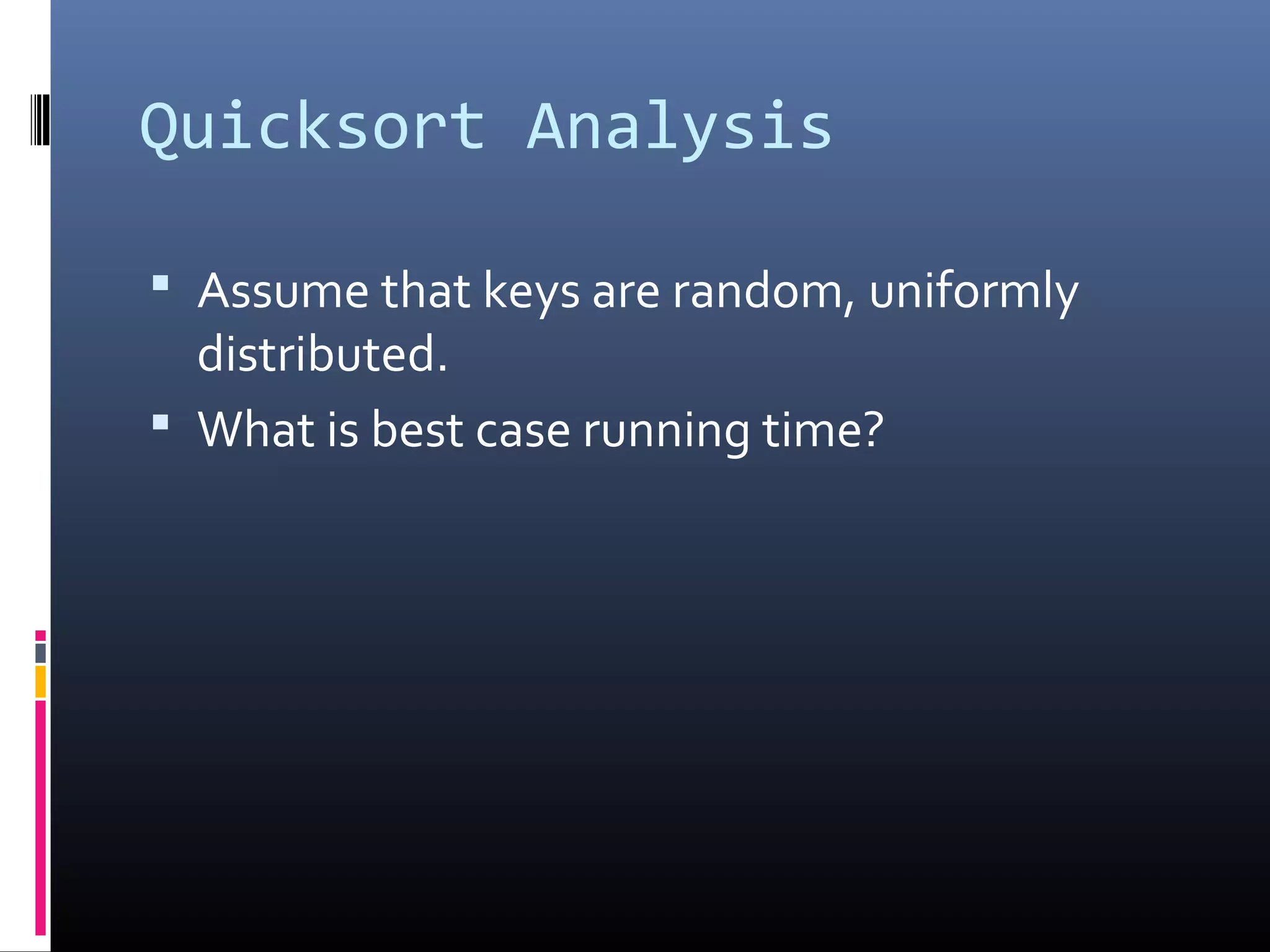
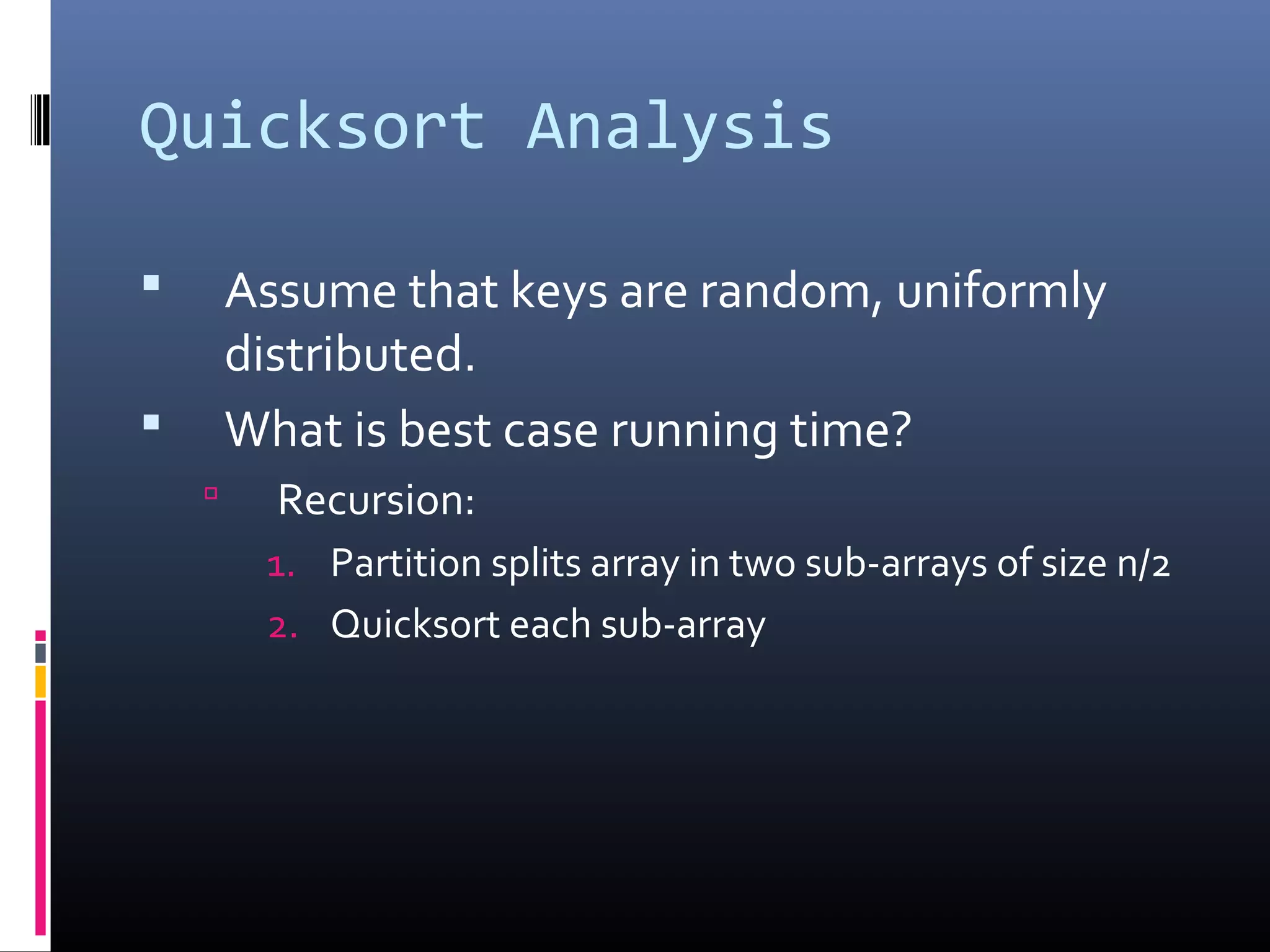
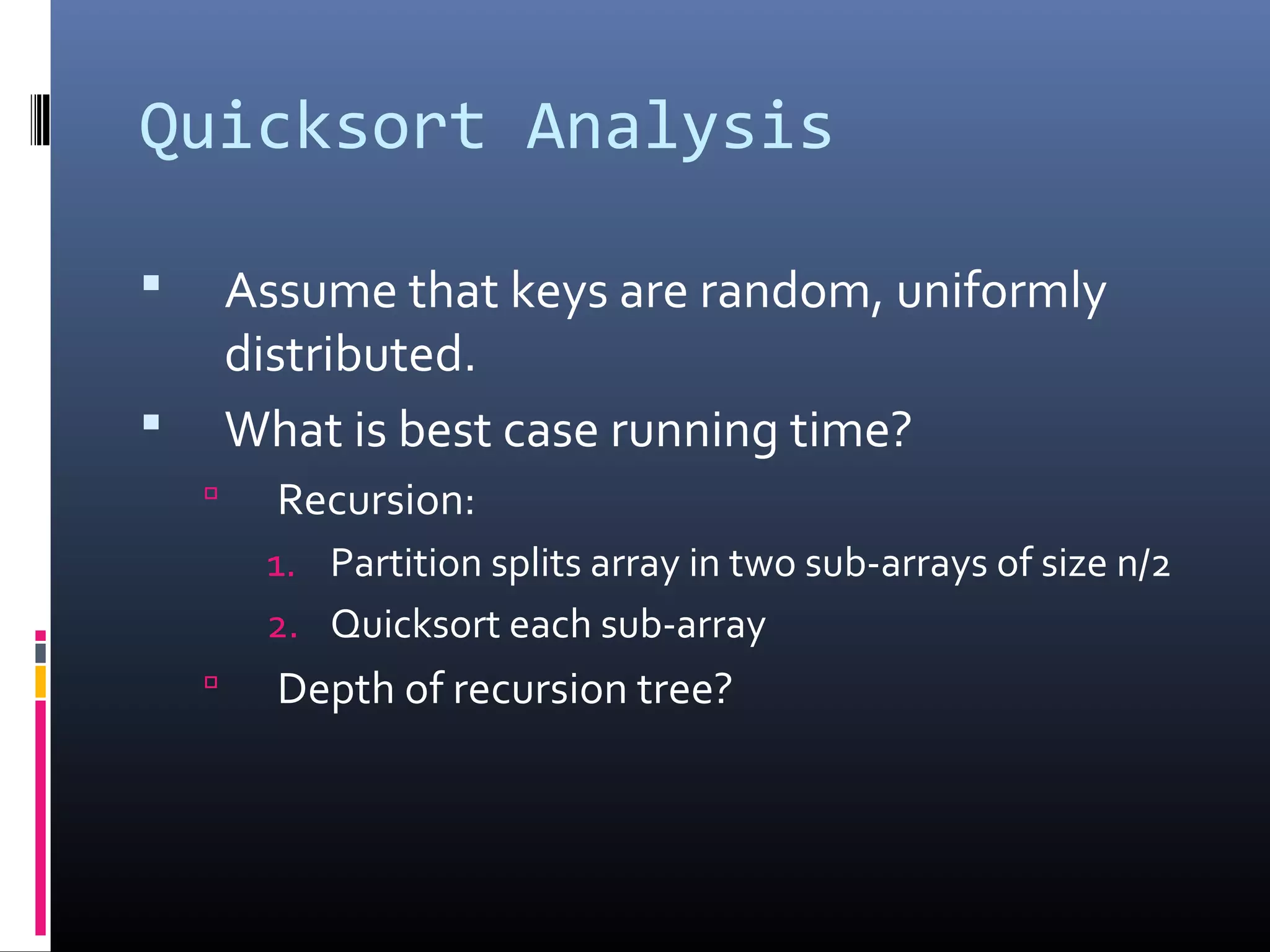
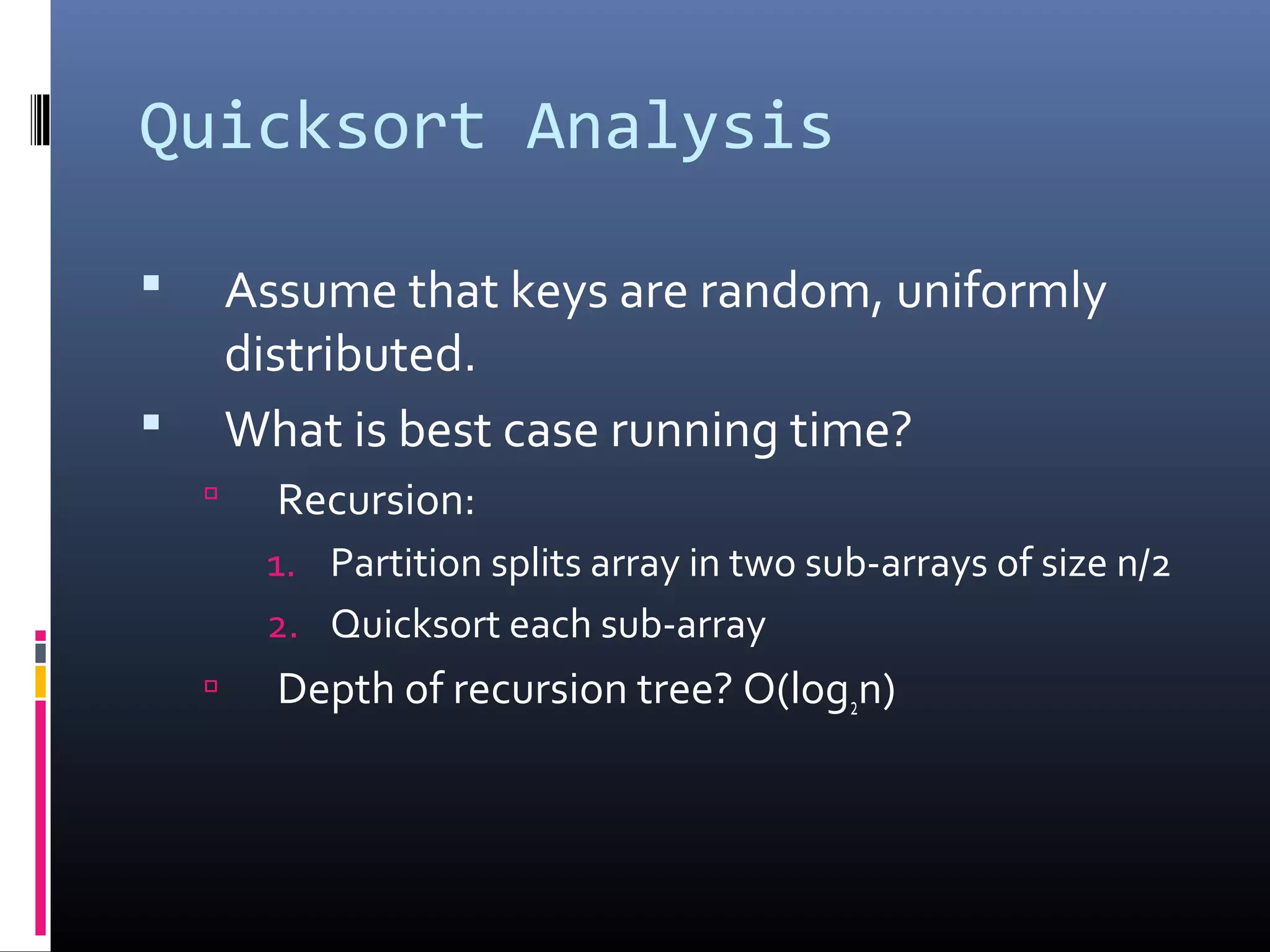
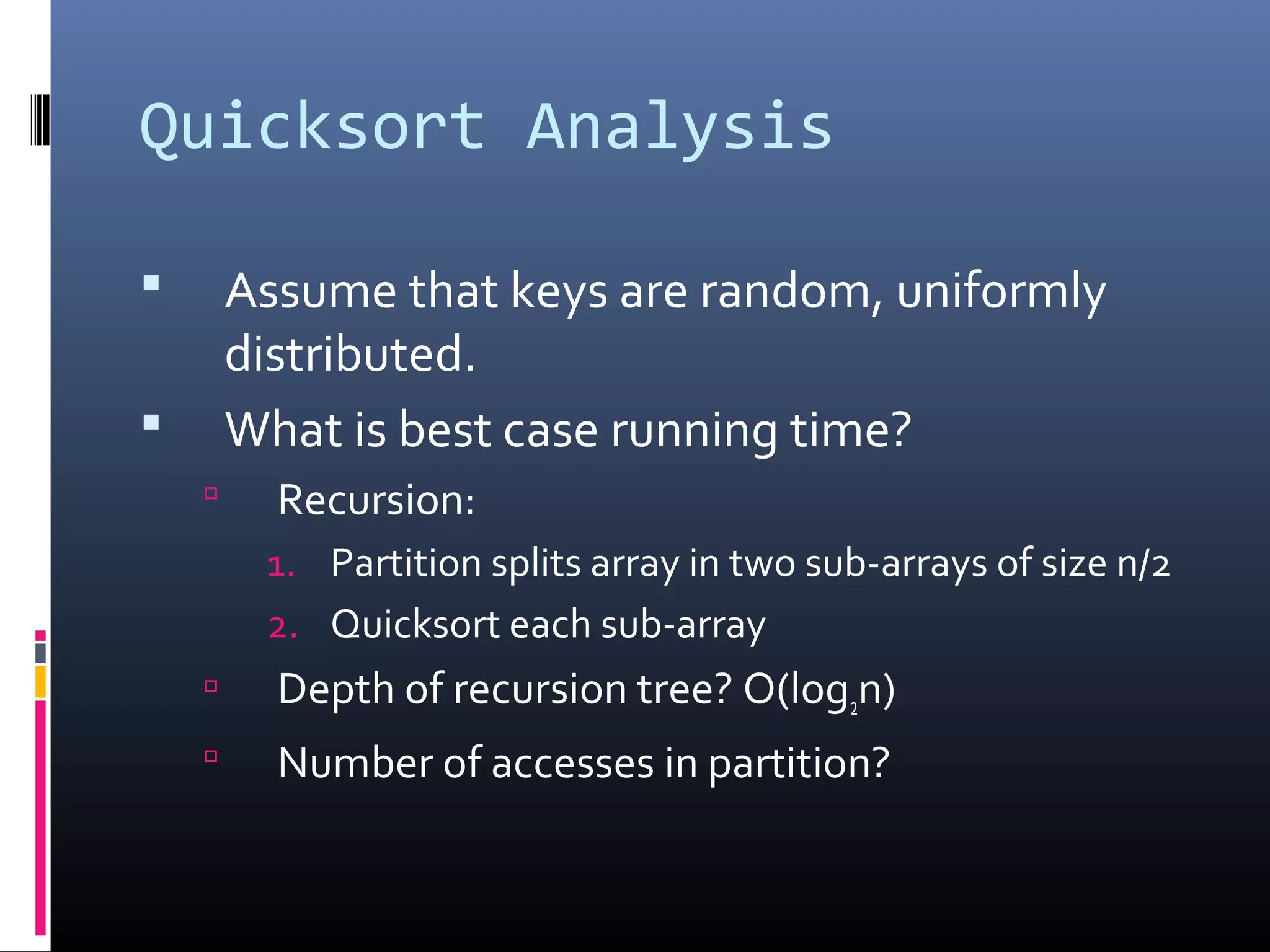
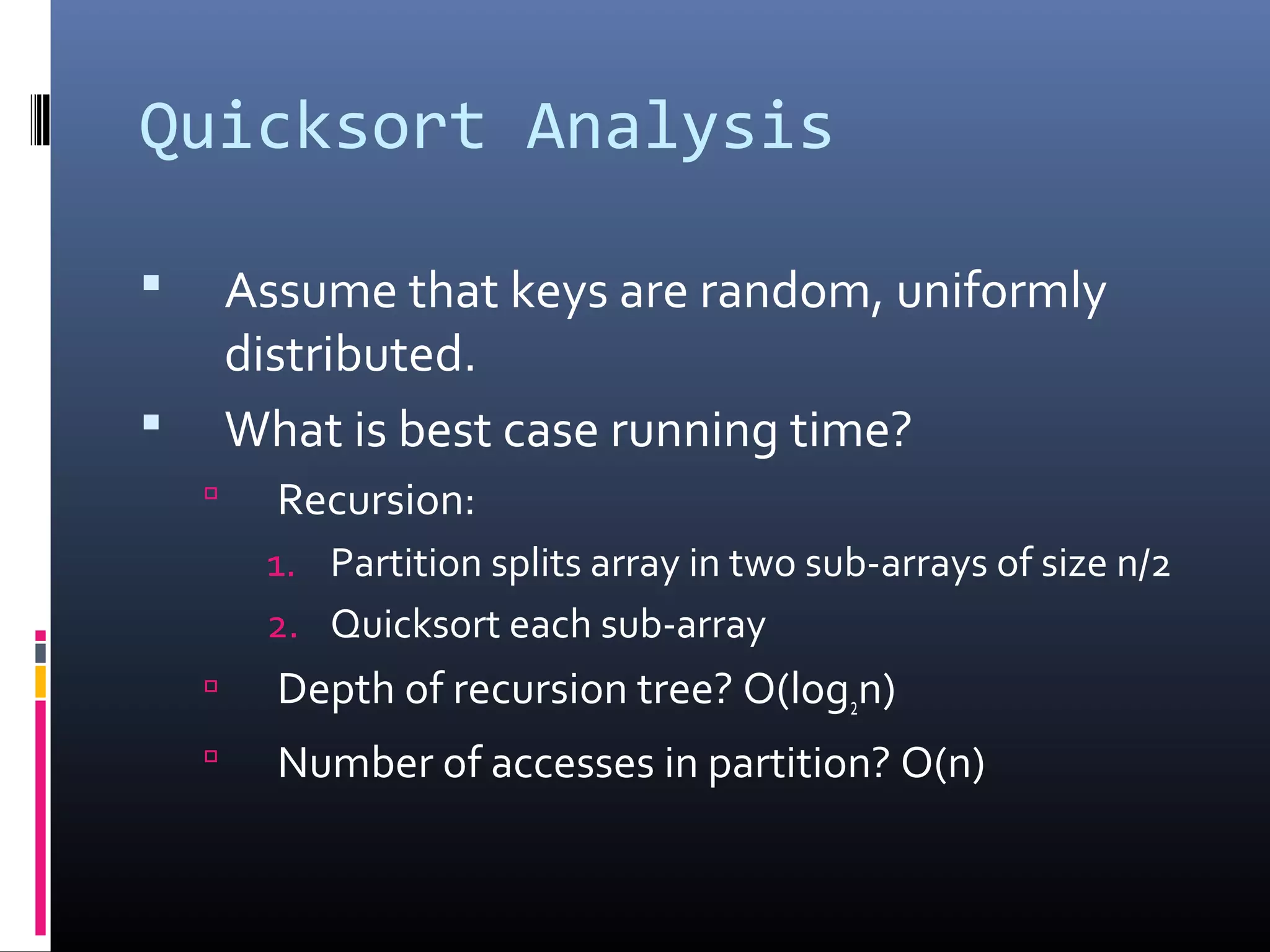
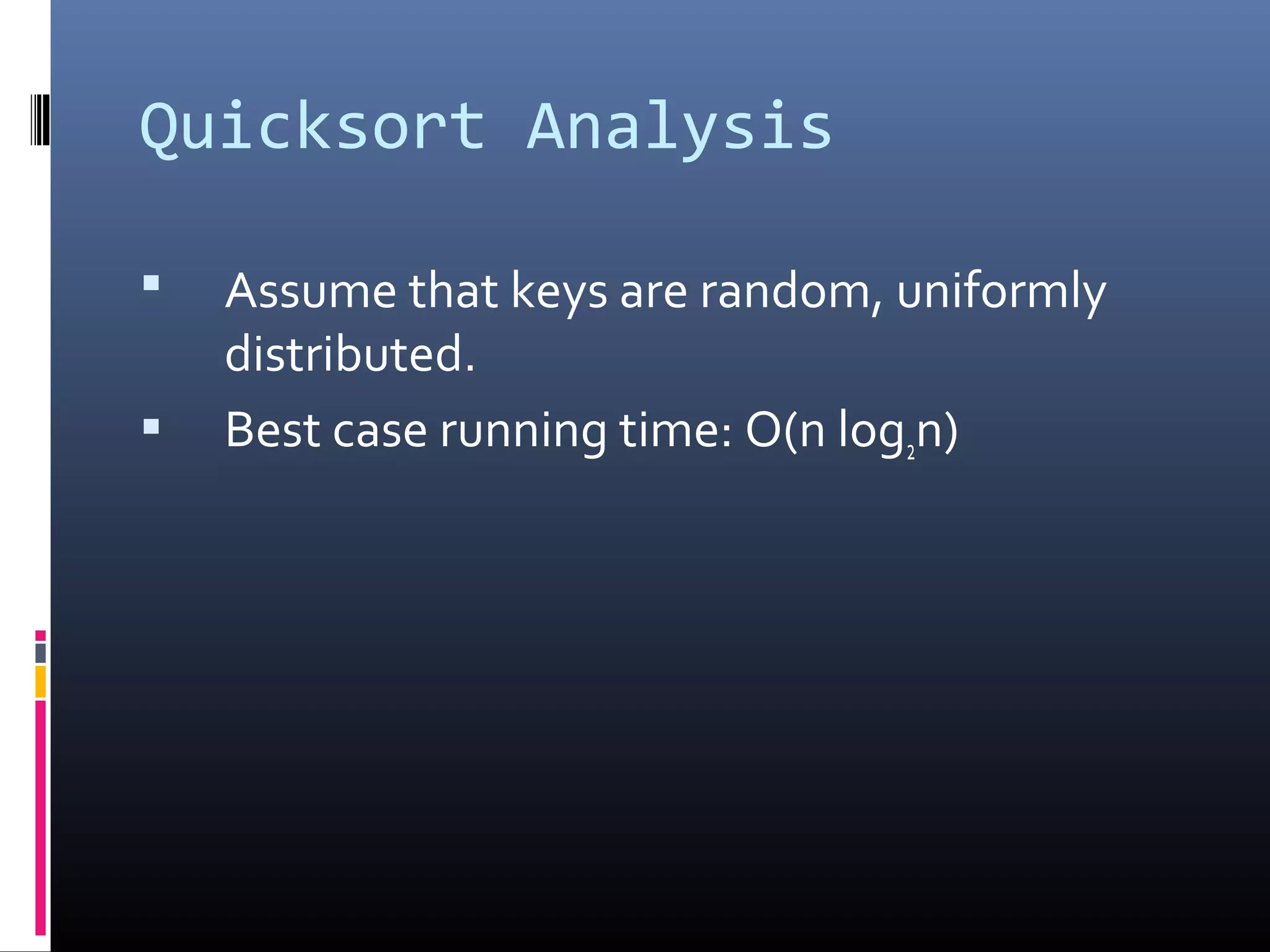
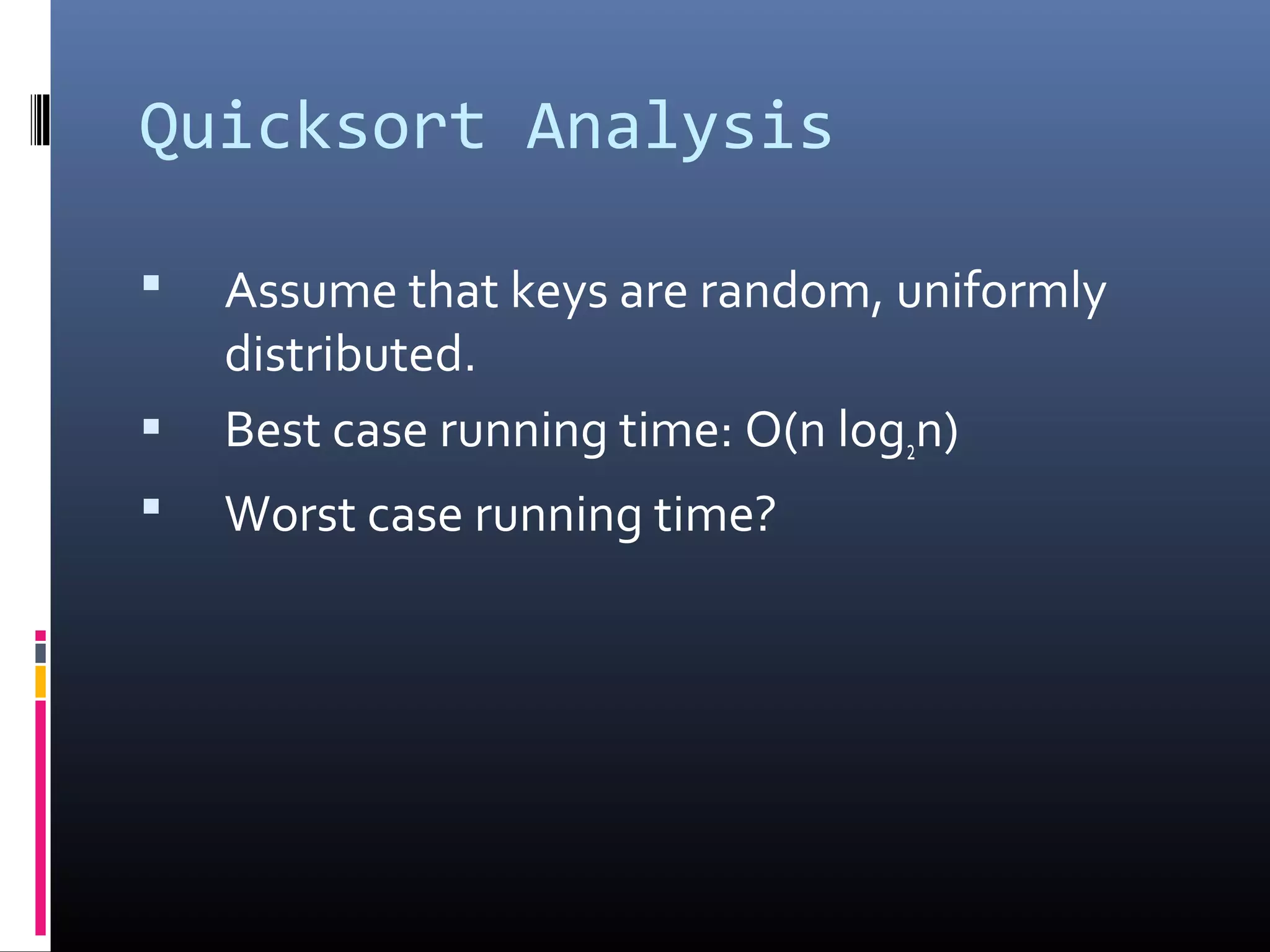
![Quicksort: Worst Case
Assume first element is chosen as pivot.
Assume we get array that is already in order:
2 4 10 12 13 50 57 63 100pivot_index = 0
[0] [1] [2] [3] [4] [5] [6] [7] [8]
too_big_index too_small_index](https://image.slidesharecdn.com/quicksort-150701093646-lva1-app6891/75/Quick-sort-11-2048.jpg)
![1. While data[too_big_index] <= data[pivot]
++too_big_index
2. While data[too_small_index] > data[pivot]
--too_small_index
3. If too_big_index < too_small_index
swap data[too_big_index] and data[too_small_index]
4. While too_small_index > too_big_index, go to 1.
5. Swap data[too_small_index] and data[pivot_index]
2 4 10 12 13 50 57 63 100pivot_index = 0
[0] [1] [2] [3] [4] [5] [6] [7] [8]
too_big_index too_small_index](https://image.slidesharecdn.com/quicksort-150701093646-lva1-app6891/75/Quick-sort-12-2048.jpg)
![1. While data[too_big_index] <= data[pivot]
++too_big_index
2. While data[too_small_index] > data[pivot]
--too_small_index
3. If too_big_index < too_small_index
swap data[too_big_index] and data[too_small_index]
4. While too_small_index > too_big_index, go to 1.
5. Swap data[too_small_index] and data[pivot_index]
2 4 10 12 13 50 57 63 100pivot_index = 0
[0] [1] [2] [3] [4] [5] [6] [7] [8]
too_big_index too_small_index](https://image.slidesharecdn.com/quicksort-150701093646-lva1-app6891/75/Quick-sort-13-2048.jpg)
![1. While data[too_big_index] <= data[pivot]
++too_big_index
2. While data[too_small_index] > data[pivot]
--too_small_index
3. If too_big_index < too_small_index
swap data[too_big_index] and data[too_small_index]
4. While too_small_index > too_big_index, go to 1.
5. Swap data[too_small_index] and data[pivot_index]
2 4 10 12 13 50 57 63 100pivot_index = 0
[0] [1] [2] [3] [4] [5] [6] [7] [8]
too_big_index too_small_index](https://image.slidesharecdn.com/quicksort-150701093646-lva1-app6891/75/Quick-sort-14-2048.jpg)
![1. While data[too_big_index] <= data[pivot]
++too_big_index
2. While data[too_small_index] > data[pivot]
--too_small_index
3. If too_big_index < too_small_index
swap data[too_big_index] and data[too_small_index]
4. While too_small_index > too_big_index, go to 1.
5. Swap data[too_small_index] and data[pivot_index]
2 4 10 12 13 50 57 63 100pivot_index = 0
[0] [1] [2] [3] [4] [5] [6] [7] [8]
too_big_index too_small_index](https://image.slidesharecdn.com/quicksort-150701093646-lva1-app6891/75/Quick-sort-15-2048.jpg)
![1. While data[too_big_index] <= data[pivot]
++too_big_index
2. While data[too_small_index] > data[pivot]
--too_small_index
3. If too_big_index < too_small_index
swap data[too_big_index] and data[too_small_index]
4. While too_small_index > too_big_index, go to 1.
5. Swap data[too_small_index] and data[pivot_index]
2 4 10 12 13 50 57 63 100pivot_index = 0
[0] [1] [2] [3] [4] [5] [6] [7] [8]
too_big_index too_small_index](https://image.slidesharecdn.com/quicksort-150701093646-lva1-app6891/75/Quick-sort-16-2048.jpg)
![1. While data[too_big_index] <= data[pivot]
++too_big_index
2. While data[too_small_index] > data[pivot]
--too_small_index
3. If too_big_index < too_small_index
swap data[too_big_index] and data[too_small_index]
4. While too_small_index > too_big_index, go to 1.
5. Swap data[too_small_index] and data[pivot_index]
2 4 10 12 13 50 57 63 100pivot_index = 0
[0] [1] [2] [3] [4] [5] [6] [7] [8]
too_big_index too_small_index](https://image.slidesharecdn.com/quicksort-150701093646-lva1-app6891/75/Quick-sort-17-2048.jpg)
![1. While data[too_big_index] <= data[pivot]
++too_big_index
2. While data[too_small_index] > data[pivot]
--too_small_index
3. If too_big_index < too_small_index
swap data[too_big_index] and data[too_small_index]
4. While too_small_index > too_big_index, go to 1.
5. Swap data[too_small_index] and data[pivot_index]
2 4 10 12 13 50 57 63 100pivot_index = 0
[0] [1] [2] [3] [4] [5] [6] [7] [8]
> data[pivot]<= data[pivot]](https://image.slidesharecdn.com/quicksort-150701093646-lva1-app6891/75/Quick-sort-18-2048.jpg)



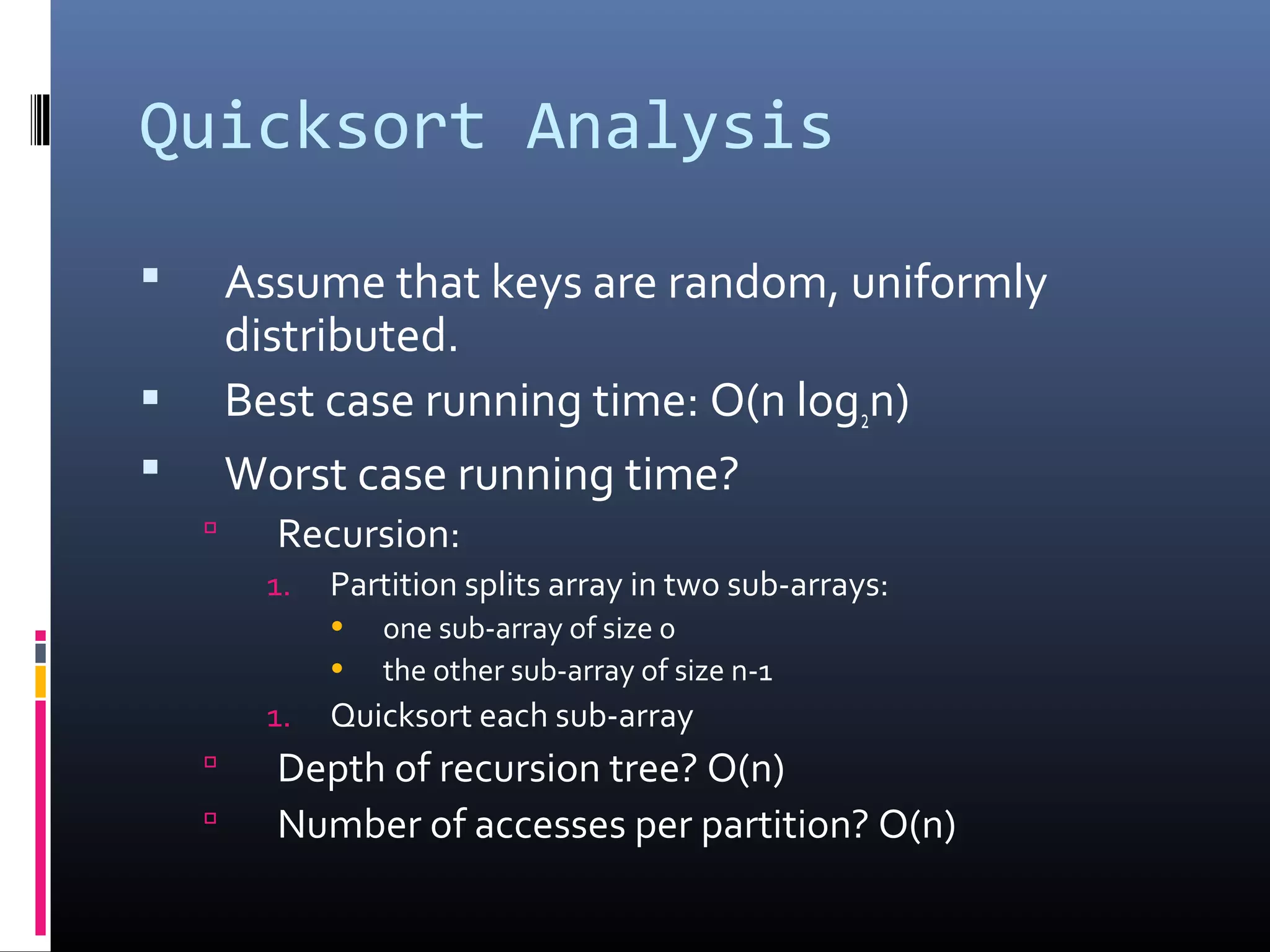

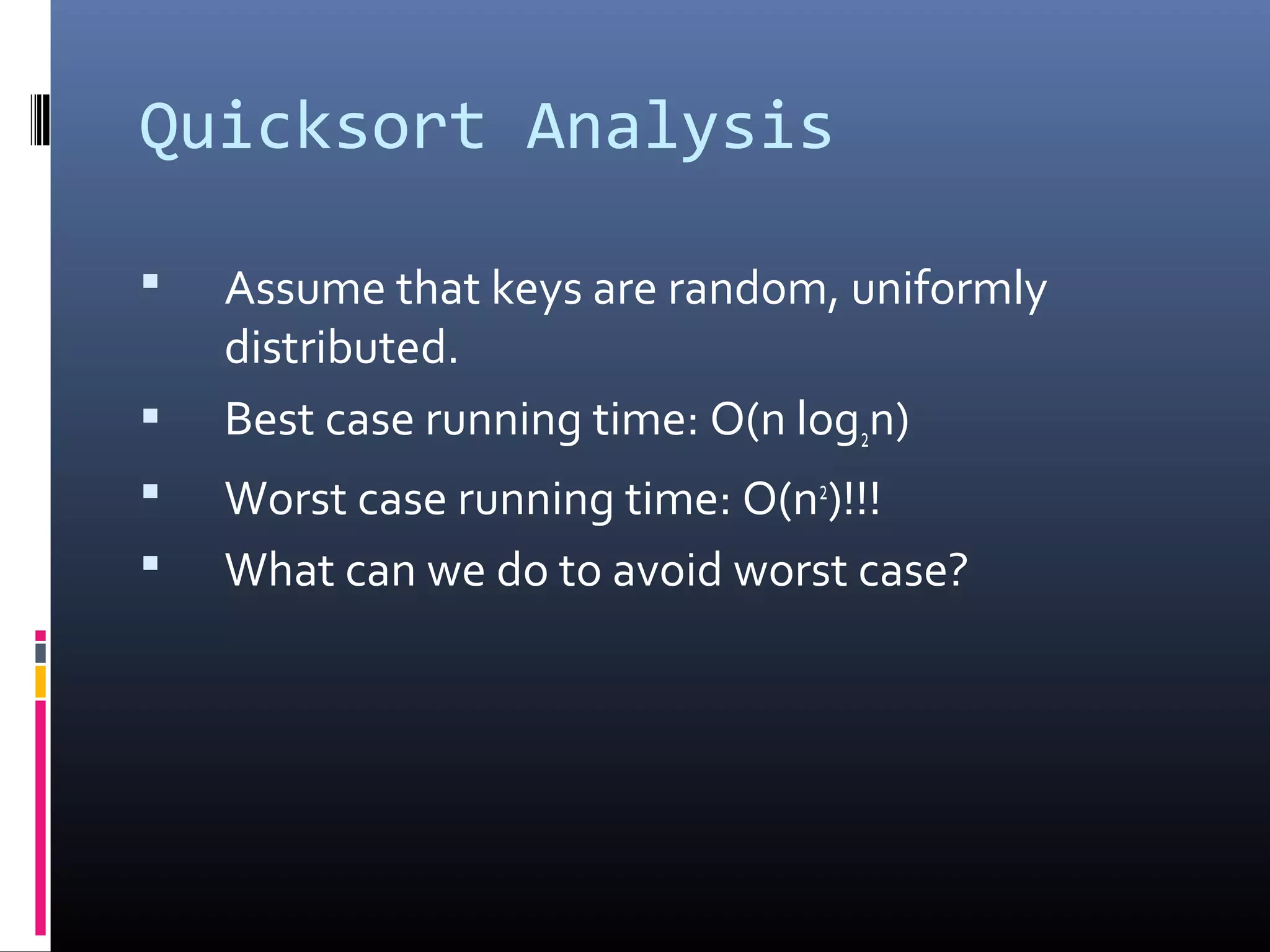
![Improved Pivot Selection
Pick median value of three elements from data
array:
data[0], data[n/2], and data[n-1].
Use this median value as pivot.](https://image.slidesharecdn.com/quicksort-150701093646-lva1-app6891/75/Quick-sort-25-2048.jpg)
![Improving Performance of
Quicksort
Improved selection of pivot.
For sub-arrays of size 3 or less, apply brute
force search:
Sub-array of size 1: trivial
Sub-array of size 2:
if(data[first] > data[second]) swap them
Sub-array of size 3: left as an exercise.](https://image.slidesharecdn.com/quicksort-150701093646-lva1-app6891/75/Quick-sort-26-2048.jpg)